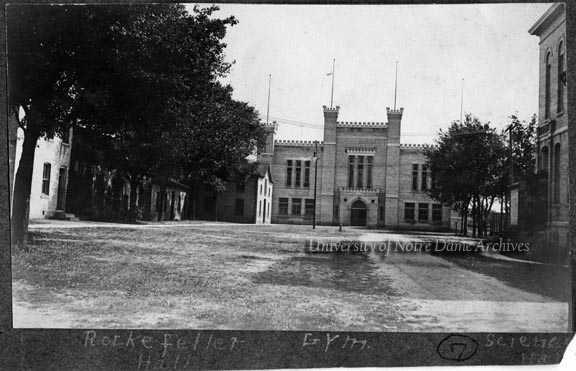
Near where Cavanaugh Hall is today, there once was a building which had the tongue-in-cheek name “Rockefeller Hall.” This building housed the University privies and possibly stables at some point, and the upper level housed transient men who came to Notre Dame in winter in search of food and lodging in exchange for odd jobs around campus.

In 1913, the University decided to forgo providing such accommodations: “That the University of Notre Dame is to do away with its famous home of tramps and hoboes, was learned last week when the faculty decided to abandon Rockefeller Hall, which for a quarter century has been the annual winter mecca for hundreds of the ‘sons of rest’ from all parts of the United States. This bit of news has caused much regret among the students, who had learned to look forward to the annual pilgrimage of the hoboes” [Catholic Columbian Record, 10/03/1913; PNDP 10-Ro-01].
The students, at least according to one contributor to Scholastic, envied their fellow “inmates” at Notre Dame because of the freedom these men had to come and go as they pleased. Rockefeller Hall was “the only hall at the University where general permission is exhibited” [Scholastic, 10/01/1913, page 96].
Rockefeller Hall was demolished in June 1931 and Cavanaugh Hall was ready for student residents for the fall of 1936.

This photograph appears in Grover Miller’s Scrapbook. Miller was on the staff of the Dome yearbook and this photo is on a page alongside other photographs clearly on Notre Dame campus. Therefore, it would not be unreasonable to assume that this scene took place somewhere on the grounds of Notre Dame.
Sources:
Scholastic
PNDP 10-Ro-01
GMIL 2/02
GMIL 2/06

When researching Rockefeller Hall, I did see reference to the old Band Annex being part of that. Unfortunately, it was difficult to find very many references about its history.
My work suggests that a small portion of the complex known as Rockefeller Hall survived until 1990 as the Band Annex (previously the first Huddle). Science Hall became the student center in 1953, or thereabouts, moving the Huddle from this remaining building, which then became the much-needed Band Annex as Father Harvey converted traditional music spaces in Washington Hall into theatre spaces (by 1956). While Cavanaugh’s construction certainly would have required the demolition of the north-south portion of Rockefeller Hall (the original gymnasium part), the east-west part (the original privies, etc.), as far south as the south front of Washington Hall, would not have been in the way and thus, I believe, managed to survive for awhile longer.